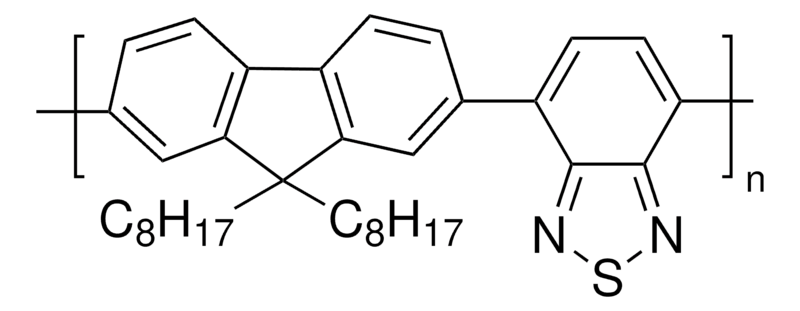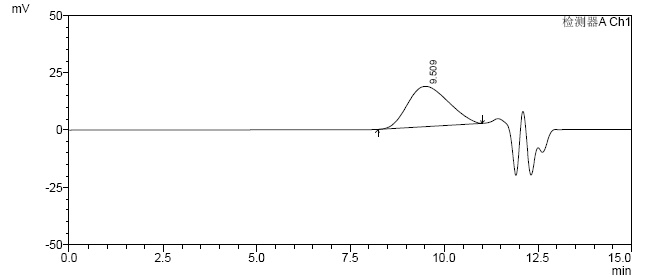F8BT CAS#: 210347-52-7; ChemWhat Code: 266950
Identification
| Product Name | F8BT |
| IUPAC Name | 4-(9,9-dioctylfluoren-2-yl)-2,1,3-benzothiadiazole |
| Molecular Structure |  |
| CAS Registry Number | 210347-52-7 |
| EINECS Number | No data available |
| MDL Number | MFCD28975851 |
| Beilstein Registry Number | No data available |
| Synonyms | 2,1,3-Benzothiadiazole, 4-(9,9-dioctyl-9H-fluoren-2-yl)- [ACD/Index Name] 4-(9,9-Dioctyl-9H-fluoren-2-yl)-2,1,3-benzothiadiazol [German] [ACD/IUPAC Name] 4-(9,9-Dioctyl-9H-fluoren-2-yl)-2,1,3-benzothiadiazole [ACD/IUPAC Name] 4-(9,9-Dioctyl-9H-fluorén-2-yl)-2,1,3-benzothiadiazole [French] [ACD/IUPAC Name] |
| Molecular Formula | C35H44N2S |
| Molecular Weight | 524.802 |
| InChI | InChI=1S/C35H44N2S/c1-3-5-7-9-11-15-24-35(25-16-12-10-8-6-4-2)31-20-14-13-18-29(31)30-23-22-27(26-32(30)35)28-19-17-21-33-34(28)37-38-36-33/h13-14,17-23,26H,3-12,15-16,24-25H2,1-2H3 |
| InChI Key | QPPJZINEHSIVEW-UHFFFAOYSA-N |
| Canonical SMILES | CCCCCCCCC1(c2ccccc2-c3c1cc(cc3)c4cccc5c4nsn5)CCCCCCCC |
| Patent Information |
| No data available |
Physical Data
| Appearance | Yellow to orange solid |
| Solubility | No data available |
| Flash Point | No data available |
| Refractive index | No data available |
| Sensitivity | No data available |
Spectra
Route of Synthesis (ROS)
| No data available |
Safety and Hazards
| GHS Hazard Statements | Not Classified |
Other Data
| Transportation | NONH for all modes of transport |
| Under the room temperature and away from light | |
| HS Code | No data available |
| Storage | Under the room temperature and away from light |
| Shelf Life | 1 year |
| Market Price | USD |
| Druglikeness | |
| Lipinski rules component | |
| Molecular Weight | 651.056 |
| logP | 19.651 |
| HBA | 2 |
| HBD | 0 |
| Matching Lipinski Rules | 2 |
| Veber rules component | |
| Polar Surface Area (PSA) | 54.02 |
| Rotatable Bond (RotB) | 20 |
| Matching Veber Rules | 1 |
| Use Pattern |
| Commonly used as organic semiconductor materials for organic field effect transistors (OFETs): As semiconductor materials for OFETs, they are used to make flexible electronic devices, such as flexible displays, sensors, etc. Used in organic solar cells (OSCs): Used as electron acceptors in organic solar cells to help convert light energy into electrical energy. Used in organic optoelectronic devices : Used to make other types of organic optoelectronic devices, such as photodiodes, photodetectors, etc. |
Buy Reagent | |
| No reagent supplier? | Send quick inquiry to ChemWhat |
| Want to be listed here as a reagent supplier? (Paid service) | Click here to contact ChemWhat |
Approved Manufacturers | |
| Want to be listed as an approved manufacturer (Requires approvement)? | Please download and fill out this form and send back to approved-manufacturers@chemwhat.com |
Other Suppliers | |
| Watson International Limited | Visit Watson Official Website |
Contact Us for Other Help | |
| Contact us for other information or services | Click here to contact ChemWhat |


